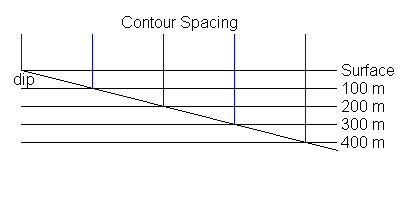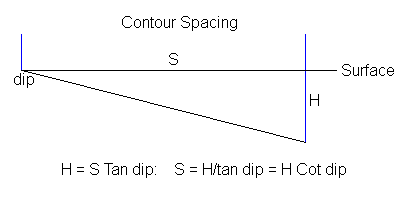Plot Structure Contours on a Plane, Given Its Strike and Dip
Steven Dutch, Professor Emeritus, Natural and Applied Sciences, University of Wisconsin - Green Bay
Structure contours are lines of equal elevation, just like topographic contours, except they are drawn on the surface of a geologic structure instead of on the land surface. The simplest contours are those on a planar structure like a stratum, a fault, or a dike.
Structure contours on a plane are:
- Always straight lines
- Always parallel to the strike of the structure
- Always parallel to each other
- Always equally-spaced if the contour interval is uniform
The critical problem in drawing structure contours is determining their spacing on the map view. There are two ways to do this.
1. Draw a simple cross-section and measure the spacing

2. Calculate the spacing trigonometrically

Interpolation
Textbook problems often use round numbers for convenience. Real geologic data are rarely so neat. You must be able to interpolate when the data are not in round numbers.
Say your outcrop is at an elevation of 871 meters. A map with contours at 871, 771, 671 ... is useless. You need to be able to construct the 800, 700, 600 .... contours.
The 871 meter outcrop will be 71% of the way between the 800 and 900 meter contours, and 29% of the way from the 900 meter contour to the 800 meter contour. After you calculate S for the diagram, calculate .71S. The 800 meter contour lies this far from the outcrop - in the downdip direction because it's lower than the outcrop. The 900 meter contour lies .29S in the updip direction, because it's higher.
VERY IMPORTANT FACT: Linear interpolation is always valid between any two points in a plane. Mathematically valid, that is. Interpolation will not detect some geological interruption of the structure, like a deep channel fill or a fault.
Example
 |
1. The problem. Construct the structure contours on this sill. 2. Determine the contour spacing, either by trigonometry or by drawing a cross-section. Note that graphical construction is not as precise as trigonometrical calculation. 3. Draw a line perpendicular to the strike and plot elevation points, interpolating as necessary. 4. Draw the structure contours parallel to the strike. |
A Note About Accuracy
If you calculate contour spacing using trigonometry, the display on the calculator will be much more precise than a spacimg measured graphically. However, the contour spacing can only be as accurate as the dip determination. Dip measurements in the field are rarely more accurate than the nearest degree, and it's not always certain that the spot where the dip was measured was truly representative.
There are enough sources of error in structural geology without adding to them artificially. Therefore, constructions and calculations need to be as accurate as possible, especially for complex operations where results from one step are used in another step. However, be aware of the limitations in the original data and report final results only to the true level of significance.
Return to Course Syllabus
Return to Techniques Manual Index
Return to Professor Dutch's Home Page
Created 5 January 1999, Last Update 12 June 2020